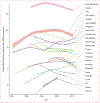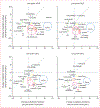Trends in the incidence of diagnosed diabetes: a multicountry analysis of aggregate data from 22 million diagnoses in high-income and middle-income settings - PubMed (original) (raw)
doi: 10.1016/S2213-8587(20)30402-2. Epub 2021 Feb 23.
Lei Chen 2, Rakibul M Islam 3, Bendix Carstensen 4, Edward W Gregg 5, Meda E Pavkov 6, Linda J Andes 6, Ran Balicer 7, Marta Baviera 8, Elise Boersma-van Dam 9, Gillian L Booth 10, Juliana C N Chan 11, Yi Xian Chua 12, Sandrine Fosse-Edorh 13, Sonsoles Fuentes 13, Hanne L Gulseth 14, Romualdas Gurevicius 15, Kyoung Hwa Ha 16, Thomas R Hird 17, György Jermendy 18, Mykola D Khalangot 19, Dae Jung Kim 16, Zoltán Kiss 20, Victor I Kravchenko 21, Maya Leventer-Roberts 22, Chun-Yi Lin 23, Andrea O Y Luk 11, Manel Mata-Cases 24, Didac Mauricio 25, Gregory A Nichols 26, Mark M Nielen 9, Deanette Pang 12, Sanjoy K Paul 27, Catherine Pelletier 28, Santa Pildava 29, Avi Porath 30, Stephanie H Read 31, Maria Carla Roncaglioni 8, Paz Lopez-Doriga Ruiz 32, Marina Shestakova 33, Olga Vikulova 33, Kang-Ling Wang 23, Sarah H Wild 31, Naama Yekutiel 34, Jonathan E Shaw 35
Affiliations
- PMID: 33636102
- PMCID: PMC10984526
- DOI: 10.1016/S2213-8587(20)30402-2
Trends in the incidence of diagnosed diabetes: a multicountry analysis of aggregate data from 22 million diagnoses in high-income and middle-income settings
Dianna J Magliano et al. Lancet Diabetes Endocrinol. 2021 Apr.
Abstract
Background: Diabetes prevalence is increasing in most places in the world, but prevalence is affected by both risk of developing diabetes and survival of those with diabetes. Diabetes incidence is a better metric to understand the trends in population risk of diabetes. Using a multicountry analysis, we aimed to ascertain whether the incidence of clinically diagnosed diabetes has changed over time.
Methods: In this multicountry data analysis, we assembled aggregated data describing trends in diagnosed total or type 2 diabetes incidence from 24 population-based data sources in 21 countries or jurisdictions. Data were from administrative sources, health insurance records, registries, and a health survey. We modelled incidence rates with Poisson regression, using age and calendar time (1995-2018) as variables, describing the effects with restricted cubic splines with six knots for age and calendar time.
Findings: Our data included about 22 million diabetes diagnoses from 5 billion person-years of follow-up. Data were from 19 high-income and two middle-income countries or jurisdictions. 23 data sources had data from 2010 onwards, among which 19 had a downward or stable trend, with an annual estimated change in incidence ranging from -1·1% to -10·8%. Among the four data sources with an increasing trend from 2010 onwards, the annual estimated change ranged from 0·9% to 5·6%. The findings were robust to sensitivity analyses excluding data sources in which the data quality was lower and were consistent in analyses stratified by different diabetes definitions.
Interpretation: The incidence of diagnosed diabetes is stabilising or declining in many high-income countries. The reasons for the declines in the incidence of diagnosed diabetes warrant further investigation with appropriate data sources.
Funding: US Centers for Disease Control and Prevention, Diabetes Australia Research Program, and Victoria State Government Operational Infrastructure Support Program.
Copyright © 2021 Elsevier Ltd. All rights reserved.
Conflict of interest statement
Declaration of interests
We declare no competing interests.
Figures
Figure 1:. Age-standardised and sex-standardised incidence rates of diagnosed diabetes per 1000 person-years (EU standard population 2010, with equal weights for men and women)
Standardisation is based on annual age-specific incidence rates from age–period–cohort models fitted separately for each data source and sex. Shaded areas represent 95% CIs around incidence trends. CHS=Clalit Health Services. KPNW=Kaiser Permanente Northwest. MHS=Maccabi Healthcare Services. NHIS=National Health Interview Survey.
Figure 2:. Estimated changes in diagnosed diabetes incidence rates before and after the join points at the years 2009, 2010, 2011, and 2012
The diagonal lines indicate equality of pre-join and post-join point changes in rates, in which there is no change in trend. Each coloured circle represents a data source; the area is proportional to the precision (inverse variance) of the sum of the estimated annual changes before and after the join point. Estimates are from a model with common slopes for men and women, controlling for sex. Model fit for the later time period is poor for Israel (MHS), leading to unreliable estimates of the annual trend in incidence in this time period. CHS=Clalit Health Services. KPNW=Kaiser Permanente Northwest. MHS=Maccabi Healthcare Services. NHIS=National Health Interview Survey.
Figure 3:. Trends in the proportion of the population undergoing HbA1c and blood glucose testing, along with diagnosed diabetes incidence, in data from Israel (Maccabi Healthcare Services)
Incident cases are defined by an algorithm, incorporating blood tests, prescription of antidiabetic medications, and clinical diagnosis by clinical practitioners.
Figure 4:. Trends in the proportion of the population undergoing HbA1c and blood glucose testing, along with diagnosed diabetes incidence, in data from Ontario, Canada (administrative diabetes database)
Incidence data depicted here are from Ontario, rather than national Canadian incidence data. Incident cases are defined by an algorithm, incorporating at least one hospital admission or at least two physician claims with evidence of diabetes within 2 years.
Comment in
- Progress in diabetes prevention or epidemiology-or both, or neither?
Ali MK, Seiglie JA, Narayan KMV. Ali MK, et al. Lancet Diabetes Endocrinol. 2021 Apr;9(4):190-191. doi: 10.1016/S2213-8587(20)30433-2. Epub 2021 Feb 23. Lancet Diabetes Endocrinol. 2021. PMID: 33636103 Free PMC article. No abstract available.
Similar articles
- Trends in all-cause mortality among people with diagnosed diabetes in high-income settings: a multicountry analysis of aggregate data.
Magliano DJ, Chen L, Carstensen B, Gregg EW, Pavkov ME, Salim A, Andes LJ, Balicer R, Baviera M, Chan JCN, Cheng YJ, Gardiner H, Gulseth HL, Gurevicius R, Ha KH, Jermendy G, Kim DJ, Kiss Z, Leventer-Roberts M, Lin CY, Luk AOY, Ma S, Mata-Cases M, Mauricio D, Nichols GA, Pildava S, Porath A, Read SH, Robitaille C, Roncaglioni MC, Lopez-Doriga Ruiz P, Wang KL, Wild SH, Yekutiel N, Shaw JE. Magliano DJ, et al. Lancet Diabetes Endocrinol. 2022 Feb;10(2):112-119. doi: 10.1016/S2213-8587(21)00327-2. Epub 2022 Jan 10. Lancet Diabetes Endocrinol. 2022. PMID: 35026157 Free PMC article. - Mortality trends in type 1 diabetes: a multicountry analysis of six population-based cohorts.
Ruiz PLD, Chen L, Morton JI, Salim A, Carstensen B, Gregg EW, Pavkov ME, Mata-Cases M, Mauricio D, Nichols GA, Pildava S, Read SH, Wild SH, Shaw JE, Magliano DJ. Ruiz PLD, et al. Diabetologia. 2022 Jun;65(6):964-972. doi: 10.1007/s00125-022-05659-9. Epub 2022 Mar 22. Diabetologia. 2022. PMID: 35314870 Free PMC article. - Lifetime risk, life expectancy, and years of life lost to type 2 diabetes in 23 high-income jurisdictions: a multinational, population-based study.
Tomic D, Morton JI, Chen L, Salim A, Gregg EW, Pavkov ME, Arffman M, Balicer R, Baviera M, Boersma-van Dam E, Brinks R, Carstensen B, Chan JCN, Cheng YJ, Fosse-Edorh S, Fuentes S, Gardiner H, Gulseth HL, Gurevicius R, Ha KH, Hoyer A, Jermendy G, Kautzky-Willer A, Keskimäki I, Kim DJ, Kiss Z, Klimek P, Leventer-Roberts M, Lin CY, Lopez-Doriga Ruiz P, Luk AOY, Ma S, Mata-Cases M, Mauricio D, McGurnaghan S, Imamura T, Paul SK, Peeters A, Pildava S, Porath A, Robitaille C, Roncaglioni MC, Sugiyama T, Wang KL, Wild SH, Yekutiel N, Shaw JE, Magliano DJ. Tomic D, et al. Lancet Diabetes Endocrinol. 2022 Nov;10(11):795-803. doi: 10.1016/S2213-8587(22)00252-2. Epub 2022 Sep 29. Lancet Diabetes Endocrinol. 2022. PMID: 36183736 Free PMC article. - Repaglinide : a pharmacoeconomic review of its use in type 2 diabetes mellitus.
Plosker GL, Figgitt DP. Plosker GL, et al. Pharmacoeconomics. 2004;22(6):389-411. doi: 10.2165/00019053-200422060-00005. Pharmacoeconomics. 2004. PMID: 15099124 Review. - International variations and trends in renal cell carcinoma incidence and mortality.
Znaor A, Lortet-Tieulent J, Laversanne M, Jemal A, Bray F. Znaor A, et al. Eur Urol. 2015 Mar;67(3):519-30. doi: 10.1016/j.eururo.2014.10.002. Epub 2014 Oct 16. Eur Urol. 2015. PMID: 25449206 Review.
Cited by
- Bioinformatics analysis of effective biomarkers and immune infiltration in type 2 diabetes with cognitive impairment and aging.
Wang Q, Yang Y. Wang Q, et al. Sci Rep. 2024 Oct 7;14(1):23279. doi: 10.1038/s41598-024-74480-8. Sci Rep. 2024. PMID: 39375405 Free PMC article. - Changes in the Epidemiological Landscape of Diabetes in South Korea: Trends in Prevalence, Incidence, and Healthcare Expenditures.
Ha KH, Kim DJ. Ha KH, et al. Endocrinol Metab (Seoul). 2024 Oct;39(5):669-677. doi: 10.3803/EnM.2024.2073. Epub 2024 Sep 25. Endocrinol Metab (Seoul). 2024. PMID: 39322188 Free PMC article. Review. - Making the Most of Familismo to Curb the Diabetes Epidemic: Early Evidence of Success Delivering the Same Intervention to Latinas at Risk for and With Diabetes.
Joachim-Célestin M, Montgomery SB. Joachim-Célestin M, et al. Clin Med Insights Endocrinol Diabetes. 2024 Sep 14;17:11795514241274696. doi: 10.1177/11795514241274696. eCollection 2024. Clin Med Insights Endocrinol Diabetes. 2024. PMID: 39291260 Free PMC article. - Associations between type 2 diabetes mellitus and risk of falls among community-dwelling elderly people in Guangzhou, China: a prospective cohort study.
Lin WQ, Liao YX, Wang JY, Luo LY, Yuan LX, Sun SY, Xu Y, Sun MY, Wang C, Zhou Q, Liu XY, Liu H. Lin WQ, et al. BMC Geriatr. 2024 Aug 29;24(1):717. doi: 10.1186/s12877-024-05314-5. BMC Geriatr. 2024. PMID: 39210251 Free PMC article. - Association between age at diagnosis and all-cause mortality in type 2 diabetes: the Renal Insufficiency and Cardiovascular Events (RIACE) Italian Multicenter Study.
Vitale M, Orsi E, Solini A, Garofolo M, Grancini V, Bonora E, Fondelli C, Trevisan R, Vedovato M, Penno G, Nicolucci A, Pugliese G; Renal Insufficiency And Cardiovascular Events (RIACE) Study Group*. Vitale M, et al. Acta Diabetol. 2024 Sep;61(9):1107-1116. doi: 10.1007/s00592-024-02294-1. Epub 2024 May 7. Acta Diabetol. 2024. PMID: 38714557 Free PMC article.
References
- Cho NH, Shaw JE, Karuranga S, et al. IDF Diabetes Atlas: global estimates of diabetes prevalence for 2017 and projections for 2045. Diabetes Res Clin Pract 2018; 138: 271–81. - PubMed
- Ogurtsova K, da Rocha Fernandes JD, Huang Y, et al. IDF Diabetes Atlas: global estimates for the prevalence of diabetes for 2015 and 2040. Diabetes Res Clin Pract 2017; 128: 40–50. - PubMed
- International Diabetes Federation. IDF Diabetes Atlas, 9th edn. Brussels: International Diabetes Federation, 2019.
- Geiss LS, Wang J, Cheng YJ, et al. Prevalence and incidence trends for diagnosed diabetes among adults aged 20 to 79 years, United States, 1980–2012. JAMA 2014; 312: 1218–26. - PubMed
Publication types
MeSH terms
LinkOut - more resources
Full Text Sources
Other Literature Sources
Medical



